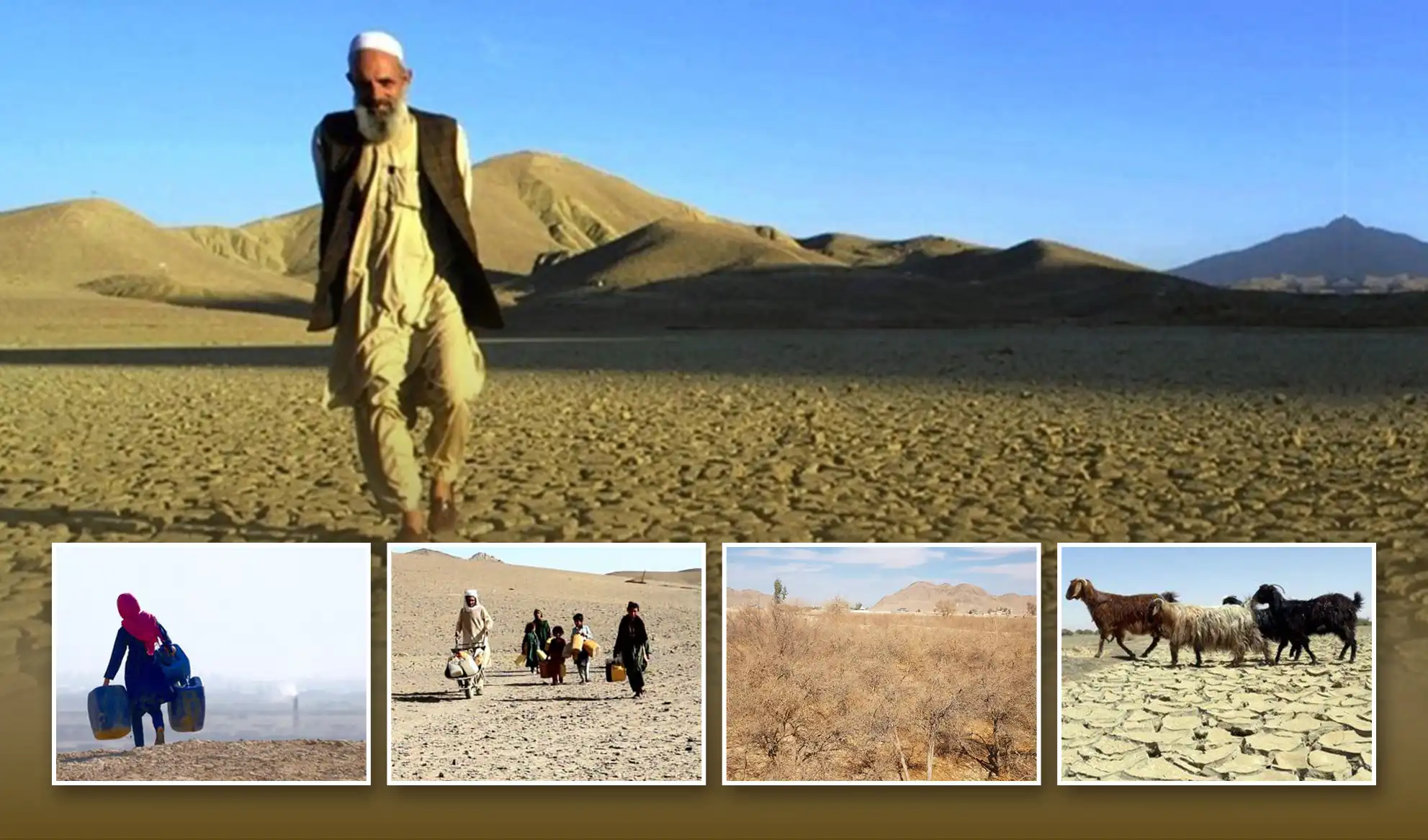KABUL (Pajhwok): Extreme weather, acute droughts, receding underground water level by an average of 11 meters, untimely rains and floods caused by climate change have led to the displacement of people and have created a host of challenges in Afghanistan.
Experts say the country’s water resources must be managed, otherwise the people will face a disaster, but the Ministry of Water and Energy says efforts are underway to manage water of the country.
Decline in rainfall
In its annual report published in 1400 solar year, the Ministry of Agriculture, Irrigation and Livestock (MoAIL) said 1650.5 millimeters rainfall happened in the country in January 2019, 993.89 millimeters in 2020 and 101.63 millimeters in January 2021.
Based on these statistics, the amount of rainfall in January 2021 has decreased by 16 times compared to the same month of 2019.
In January 2019, the amount of rainfall in Nimroz province was zero, but the average amount in Helmand, Farah, Kandahar and Nangarhar provinces was 11.9 mm and in the rest of the provinces the average amount was 55.2 mm.
In January 2020, the amount of rainfall reached the lowest 5.7mm in Baghlan, Nangarhar, Balkh, Bamyan and Samangan provinces. But the average rainfall in the rest of the provinces was 33.3mm during the period.
In January 2021, the amount of rainfall in 15 provinces (Uruzgan, Zabul, Farah, Daikundi, Nimroz, Kandahar, Ghazni, Parwan, Kapisa, Logar, Helmand, Kunduz, Ghor, Maidan Wardak and Nangarhar) was zero and the average amount of rainfall in other provinces was 5.3mm.
Last month, the Meteorological Department published a report, saying the lowest amount of rain was recorded in Herat, Lashkargah (the capital of Helmand), Kandahar and Chaghcharan (the capital of Ghor) in 2021 compared to the past five years.
According to AMD, based on information of weather stations in the certain areas, the average rainfall in 2018 was about 540mm, in 2019 about 1,610mm, in 2020 about 1,110mm, in 2021 about 260mm and in 2022 about 610mm.
According to MAIL information, there are a total of 2.2 million hectares of irrigated land and 1.1 million hectares of rain-fed land in Afghanistan and 10 percent of the irrigated land is irrigated using modern technology.
According to the second national report on climate change, published by the Environment Protection department in 1396 solar year, the central highlands of Afghanistan witnessed a decrease of almost 40 percent in spring rainfall and since then, according to the forecasts of this department, five up to 10 percent decrease in rainfall in the central and eastern highlands of the country is expected up to 1429 solar year.
Lowering underground water level
In the last five years, the decrease in rainfall and excessive use of water in Afghanistan has caused the underground water level to drop by 11 meters on average.
Pajhwok Afghan News asked 20 people in 10 provinces of the country (Kandahar, Nangarhar, Balkh, Herat, Kabul, Baghis, Laghman, Khost, Parwan and Baghlan) about the extent the water level has decreased in last five years.
They shared figures with Pajhwok about the decrease in water level of wells in their areas in the last five years.
According to these figures, in the last five years, the water level in these provinces, which can represent the whole country to some extent, has dropped by 11 meters on average.
Nisar Ahmad, a resident of Farah city, said the water well of his house dried up last year and now he brought home drinking water from an ice company.
As the water level continues to plummet, citizens of the country, especially the residents of Kabul, are struggling with the challenge of water shortage and they travel long distances to fetch water they need.
Qais, 9, a resident of Koh-i-Afshar in Kabul and a second-grade student, after coming home from school under scorching sun, carries water from Bagh Bala mosque to his home.
He said one barrel of water was not enough for his family and his sister also assisted him in carrying water.
Shafiullah Zahid, head of water supply in Kabul, also said 40 out of 76 water wells belonging to this directorate, had dried up.
According to his information, the water supply system in Kabul is designed for three million people in Kabul, but now with 36 water wells active in Kabul city provide water to 40 percent of the residents and 70 percent of residents living on mountains do not have water supply services.
Climate change impacts
Rohullah Amin, head of the climate change in the Environment Protection department, says that since 1329 solar year, the average temperature in the country has increased by 1.8 degrees and this change has caused frequent droughts, untimely rains, floods, and decreased agricultural yields.
According to him, untimely rains and continued drought in the last 10 years have had devastating effects on agriculture, and during this period, more than 100,000 hectares of agricultural land and 46,000 hectares of gardens were lost to drought and floods.
The Ministry of Foreign Affairs said Afghanistan has suffered more than two billion dollars due to impacts of climate change.
Abdul Qahar Balkhi, MoAF spokesman, said the international community’s assistance was vital to prevent possible damages and prepare the society to deal with the consequences of climate change.
Balkhi said that such support is necessary until Afghanistan achieves economic stability.
Gul Mohammad, a farmer in Nad Ali district of Helmand province, said: “In previous years, we used to harvest 400 to 600 watermelons from one acre of land, but this year the land did not produce any because of lack of water.”
Pacha Khan, a resident of Trinkot city, the capital of Uruzgan province, also said: “In the past when there was water, farmers would cultivate all their land, but due to recent droughts, the farmers cannot cultivate half of their land.”
Meanwhile, Mohammad Halim Rafi, spokesman of the National Statistics Office, says: “The total cultivated land in year 1402 reached 2.8 million hectares, of which two million hectares are irrigated and more than 800,000 hectares are rain-fed. It shows a 7.7 percent increase compared to previous years.”
Drought affects animals
Sadr-i-Azam Usmani, deputy minister of the Ministry of Agriculture, Irrigation and Livestock says: “Unfortunately, more than two hundred thousand cattle have been lost to the droughts during the last few years.”
In the second climate change report of the Environment Protection Department published in 2016, the population of cows and sheep and goats decreased from five million cows and 30 million sheep and goats to three million cows and 16 million sheep and goats in Afghanistan, showinf a 50 percent drop in the livestock sector.
Abdul Ahad Qalil, head of natural resources at the Ministry of Agriculture, said the lack of seasonal rains caused the loss of fertile lands and grasslands in northern provinces of the country, leading to destruction and reduction of livestock.
He says: “The grasslands in these provinces have been completely destroyed due to the drought, and the livestock have nothing to eat. Even some farmers moved their livestock to Ghor province and other provinces where there is grass. Some of these farmers have even been forced to sell their animals at a very low price.”
Displacement of people due to lack of water
Abdul Mutallab Haqqani, spokesman of the Ministry of Refugees and Repatriation Affairs, says their assessment shows due to lack of water and droughts in recent years, a number of people in Nimroz, Farah, Ghor and Herat provinces have moved to districts and provincial centers.
According to him, in the past year, 108,000 people were displaced from their main areas due to the lack of water.
The assessment of government ministries shows drought in the current solar year has severely damaged at least twenty provinces of Afghanistan in the north, northwest, southwest and central parts of the country.
Abdul Aziz, 46, hailing from Sardasht area in the capital of Nimroz province, said that due to the lack of water, he and his family moved to the city of Zaranj.
He said that he had a garden and agricultural land in Sardasht area, but it was not irrigated due to lack of water. He also pointed out that drinking water in the mentioned area was also salty and they now lived in the city of Zaranj.
“Steps must be taken to prevent disaster”
Prof. Mohammad Dawood Shirzad, head of the Faculty of Environment of Kabul University, says that Afghanistan is the sixth country affected by climate change in the world, and the country’s climate change situation is moving in a negative direction.
According to him, one of the causes of drought in Afghanistan is that the rainfall has become less and unbalanced, it does not rain when it is needed, and it starts raining when there is no need for rain.
Shirzad says, during the last ten years in Kabul, which is a densely populated city and where water consumption is higher, the water level has dropped by 10 meters.
He adds: “Unfortunately, this is a very serious shortage, if it is not prevented, it will lead to a disaster.”
He said that the government and the people have a responsibility to work together to solve this problem, the government must manage water and if this is not done, Afghans will face a disaster due to water shortage.
Shirzad asked the people to save water and dig wells for the used water so that the water can seep into the ground again.
On the other hand, Qari Mutiullah Abed, spokesperson of the Ministry of Energy and Water, says that since several decades, due to climate changes in the world, population density, economic, agricultural and industrial activities and other factors, the need for water is increasing day by day. Water supply sources are becoming limited and Afghanistan is among the most vulnerable countries in the world.
He added, without providing details, that this problem has been mostly seen in the western, southwestern, central and southern provinces of the country, but other parts of the country are also not safe from its negative effects.
Abed says for various reasons the balance of underground water supply and discharge is not equal in most areas.
He also said the ministry was committed to curbing water overuse and had implemented several projects in this regard and work on some dams, including the Farah Bakhshabad dam, was ongoing.
According to him, several projects have been implemented in the Qargha dam of Kabul and the water of the Paghman valleys has been controlled, the arbitrarily digging of deep wells has been prevented and there has been progress in transferring water from Panjshir province and Shah Arous dam to Kabul.
sa/ma








GET IN TOUCH
NEWSLETTER
SUGGEST A STORY
PAJHWOK MOBILE APP